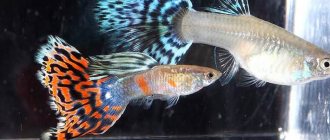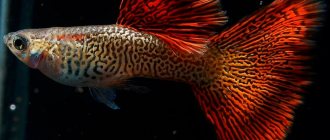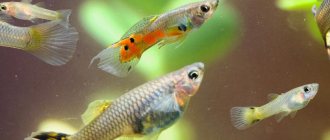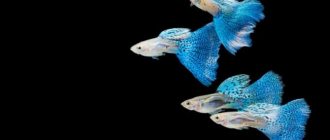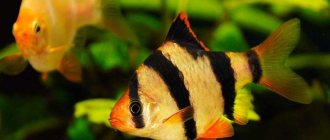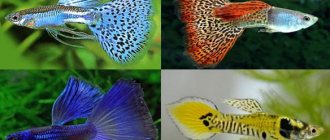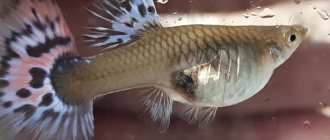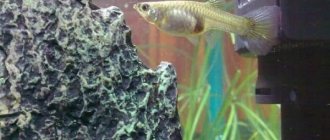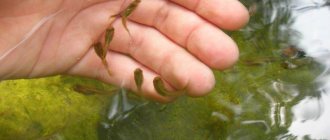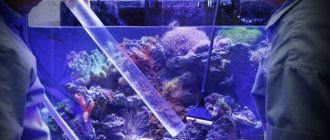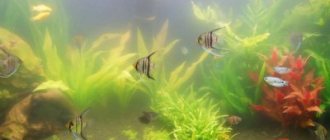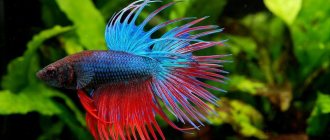4.5
(2)
Guppies are the most popular species of aquarium fish. Therefore, the “dwarf” version of this fish, also known as Endler’s guppy, is also often found in home aquariums. These fish were discovered only in 1937. They appeared at home quite recently. But their bright color, miniature size and unpretentiousness to living conditions have already managed to win favor. They are also very active and interesting to watch.
Some scientists still believe that dwarf guppies are the same species as common guppies. After all, their crossing can produce healthy offspring, and in the wild their habitats coincide.
Introduction
Small and incredibly diverse aquarium fish, guppies are known to everyone.
Not long ago, dwarf guppies or Endler's guppies began to appear in home aquariums. These miniature creatures were discovered in the rivers of Venezuela, where they were first observed and described by Franklin F. Bond. Dwarf guppies became known to a wide circle of aquarists after they were once again discovered by John Endler (this happened in 1975). In the literature, dwarf guppies are most often called “Endler’s guppies”. Endler's guppies were first found in Laguna da Patos, which is located in northern Venezuela in 1935. At first, guppies of this species lived in a salty backwater, which was separated from the ocean waters by a narrow strip of land. Over time, numerous precipitations made the water in this lake fresh. At the time of the discovery of this species of fish, the reservoir was filled with algae, with hard water at elevated temperatures. Currently, dwarf guppies are classified as an endangered species.
— Advertising —
The size of Endler's guppies is really very small: males grow no more than 2-2.5 cm, females are slightly longer - 3.5 cm. The body of the fish is slightly elongated and flattened on the sides. The body of females has one color - golden or silver. There is a small dot at the back of the abdomen that indicates the formation and development of embryos. The body of males is brightly colored - specimens are known to be red, orange and purple with bright emerald spots and black bean-shaped markings on the sides. These spots become discolored in case of excitement or stress. The color of the dorsal fin varies from red to shades of blue; there may be spots of various colors on the surface of the fin. The central part of the caudal fin is transparent, the side rays are yellow, orange or red. Sometimes there is a black border along the edge of the side rays of the tail.
Endler's guppies do not live long - only 2-3 years.
Description
Endlers live in northeastern Venezuela. Smaller in size than other guppies.
Appearance
The maximum size of Endlers is 4 cm. The male’s oblong body has yellow, orange, purple and emerald spots. The eyes are big. The fins and tail are not as bushy as those of other guppies. The translucent tail is brightly colored around the edges. Females are silver or golden.
Behavior
Guppies are a friendly and active species. Endler's fish play, rushing around the entire aquarium. They stay in a flock.
Lifespan
Guppies live 1.5–5 years depending on their quality of life and water temperature. In warm water they grow faster, but live shorter.
Content Features
Miniature Endler guppies are extremely easy to keep. Dwarf guppies prefer to live in schools and for a home aquarium it is recommended to purchase two or three pairs of fish of this species. It is important to choose a company from individuals of the same breed, so that there is no accidental mixing and degeneration of valuable traits. Only males can be part of one flock.
Aquarium
— Advertising —
To keep a flock of Endler's guppies, a very small aquarium is suitable. They use so-called nanoaquariums, which are small containers of 40 liters or less. To saturate the aquatic environment with oxygen, a compressor is placed in the aquarium, but its operation should not create strong water movement (in their natural habitat, these small fish do not like large currents). Dwarf guppies are very active and can jump out of the water, so the aquarium must be equipped with a lid.
Water
To fill the aquarium with Endler's guppies, use settled water with medium hardness and a slightly alkaline reaction. The best temperature for these fish is considered to be 22-26 degrees. At temperatures above 26, accelerated development and aging of fish occurs.
Priming
The bottom of an aquarium with dwarf guppies is covered with small river pebbles or coarse sand and densely planted with algae. This will bring the fish’s living conditions closer to natural ones, since in nature fish like to hide in thickets. They use plants that, when growing, reach the surface of the water and floating algae. The lighting of the aquarium should be dim – in bright light the fish turn pale.
Compatibility with other fish
Guppies are peaceful fish and get along well with similar species. It is important that they are also small. Good neighbors can be: corydoras, cardinals, neons. Aggressive, overly active and large fish species will be bad neighbors for these guppies. You should not put dwarf and common guppies in the same aquarium. They will begin to interbreed freely and form hybrids.
Fish like to live in small schools. Females exhibit territorial behavior and are not very tolerant of other females, and males court multiple females. This must be taken into account when choosing the number of fish for an aquarium of a certain size, as well as their sexual diversity.
Endler's guppy white peacock
What to feed Endler's guppies?
Dwarf guppies are omnivores, like many aquarium fish.
Live, dry or frozen food is suitable for feeding them. The mouth opening of this species of fish is very small, so any food will have to be crushed or pinched off in small portions. The plant component in the diet of Endler's guppies must be present - this is due to the peculiarities of their digestive system. For them, choose food that includes spirulina or similar components
General information
Endler's guppy, or dwarf guppy (Poecilia wingei) is the closest relative of the well-known viviparous fish. And although the species was first described back in 1937, the fish became widespread in aquarium culture only decades later, after their “second discovery” by John Endler, after whom the species was named.
The main difference between Endler's guppy and its famous relative is size. The fish are miniature, males barely exceed two centimeters. But at the same time they have variegated colors, are unpretentious in maintenance and easily reproduce due to viviparity.
At the moment, a large number of forms with original colors have already been received.
How to distinguish a male from a female?
It is not difficult to distinguish male and female Endler's guppy.
Individuals of different sexes, first of all, differ in size - the female dwarf guppies are always larger than the male.
Male individuals are brighter in color. On the entire surface of the body of males, spots of different colors with neon reflections are clearly visible - orange, red, bright yellow or emerald. Oval spots are scattered randomly on the sides of the body, the clarity of which may vary. The lush caudal fin is painted in bright colors, the colorless area in the center is outlined by a dark stripe. The fin near the anus is modified into a gonopodium (a special tube that is used during reproduction).
Females are more modestly colored. Their bodies are mostly silver or golden faded tones with a slightly noticeable metallic sheen. Some females have a black spot on the side of the abdomen.
Feeding
Endler's guppies living in the wild feed on insect larvae, small worms and algae. When kept in captivity, it is better to give specialized dry food to fish.
When choosing food for dwarf pets, you need to remember that they have a small mouth and try to stay in the middle and upper layers of water. Guppies are optimally suited for feeding Endler:
- Tetra Micro Crisps. Available in the form of red and green chips. The former contain animal products and carotenoids to enhance color. The latter are made from plant components and support the vitality of fish.
- TetraPro Algae. Complete food in the form of chips is produced using low-temperature gentle technology. It is enriched with vitamins and nutrients and contains spirulina concentrate.
- Tetra Phyll. Basic food made in the form of flakes and intended for ornamental fish. It is enriched with plant components and has a good effect on the health of pets.
Important! Endler's guuppies should not be given frozen food. Cold food is bad for the health of tiny heat-loving fish.
Reproduction of Endler's guppies
Endler's guppies are viviparous; breeding them is not particularly difficult.
These fish reach sexual maturity early and can reproduce as early as 2 months of age. The eggs are fertilized inside the female's body by the male's gonopodium (a special organ into which the anal fin of the male individual has turned). The development of eggs occurs in utero for 22-24 days, after which the female spawns the formed fry. At one time, the female produces from one to three dozen small fish.
From the moment of birth, the fry are given Artemia nauplii. For the first two weeks, babies are fed three times a day in small portions, after a while they are transferred to feeding twice a day. At the age of 1.5 months, the fry acquire the coloration of adults and from this time they are fed once a day.
Adviсe
- To update the gene pool, periodically acquire new males.
- Place the aquarium away from sunlight to prevent algal blooms.
- To control the number of fry, add platies or mollies to the aquarium.
- In the summer, cool the water with ice packs.
- Keep newly acquired fish separately for 3-4 weeks. Monitor their condition, if no diseases appear, transplant the fish into a common aquarium.
- The transition from one water parameters to others should be smooth. You cannot move a newly purchased specimen from the package to the aquarium. Add new water to the bag gradually at intervals of 15–20 minutes. When most of the water has been replaced, release the fish into the aquarium.
Poecilia wingei is an endangered species due to pollution. The natural population of Endlers remains in only one lake.
Previous
FishCompatibility of all cichlids with other fish in the aquarium
Next
FishRecommendations for caring for swordtail fish in an aquarium
Endler's guppy diseases
Like regular guppies, Endler's guppies have good immunity and resistance to diseases.
But it should be remembered that fish of this species are heat-loving creatures and are very sensitive to any change in temperature. If the temperature in the aquarium is too high (more than 28 degrees), the fish suffocate due to lack of oxygen.
At low temperatures (below 20 degrees), the health of the fish deteriorates sharply, which often leads to the loss of a pet.
Basic compliance with the temperature regime in the home of Endler's guppies will help to avoid many problems that are associated with their health.
If the fish’s condition does not return to normal, you should contact a specialist and begin drug treatment.
Breeding
The fish are very prolific. Guppies can give birth almost every month. This is a viviparous species, so the fish do not spawn. The female immediately gives birth to small, formed fry, from 5 to 25 in one brood. The fry immediately begin to eat regular food, such as cereal. Enedler's guppies are not inclined to eat their young, but just in case, it is worth placing the young in another aquarium. Especially if guppies are not the only inhabitants of the aquarium.
Maturity in fish occurs at the age of two months. Spawning can take place in a community aquarium. For fry, it is better to add moss; it is a good natural shelter for them. Under favorable conditions, fish live approximately 3-5 years.
Types of Endler's guppies
Endler's guppies, due to the peculiarities of their development and reproduction, have long been the object of work by breeders. As a result of crossings, many varieties have appeared that surprise with the variety of colors.
Endler's Gold Guppy
Guppy Golden Endler has a body with a golden tint with randomly scattered reddish specks. This breed is considered the most popular.
Endler's Tiger Guppy
Endler's Tiger guppy is an interestingly colored fish with clear dark stripes. There are many dark dots scattered throughout the body, from which an original pattern is formed.
Endler's Cobra Guppy
Endler's Cobra Guppy (Dragon Tuxedo Guppy) - the body color of this fish resembles snake skin.
Endler's Japanese Blue Guppy
Endler's guppy Neon Blue (Japan Blue) is distinguished by its original neon color with a bluish tint. On the side of the body there is a dark spot that looks like a bean.
Habitat
Endler's guppies were discovered and described by Franklin F. Bond in 1937. The researcher caught the first specimens in Lake Laguna de Patos (Venezuela). This unusual body of water was once part of the ocean, but isolation by a narrow strip of land and regular rains contributed to the water in the lake becoming fresh. However, the fish did not gain popularity at that time. Moreover, it was considered extinct for a long time, until the research expedition of Dr. John Endler discovered this species again. This was the “rebirth” of the fish, but this time the fish was infinitely loved by aquarists and spread widely throughout the world.
Endler's guppies - endemic to Venezuelan lakes
Endler's guppies are endemic to coastal Venezuelan lagoons, but their numbers are currently in decline due to pollution of their natural habitats. The species is considered endangered in nature, but thrives in aquariums.
Interesting Facts
- A female Endler's guppy can store a male's sperm in her body for three months and can give birth three times without a male. Professionals use this and, by crossing individuals of different breeds, expect three broods of fry.
- Female Endler's guppies are inconspicuous and inconspicuous. But each male of this species of guppy has a unique coloring, which is not repeated in other individuals of the same breed.
- It turns out that female guppies are capable of becoming males and fertilizing others. This rather rare phenomenon is described in many scientific sources. There is a known case when a female who lived alone in an aquarium gave birth to fry.
Reviews
Poecilia wingei is a delight for beginners and experienced aquarists alike. Some people spend a lot of time watching guppies. Some aquarists keep only males in a decorative aquarium, while others cross different types of guppies.
